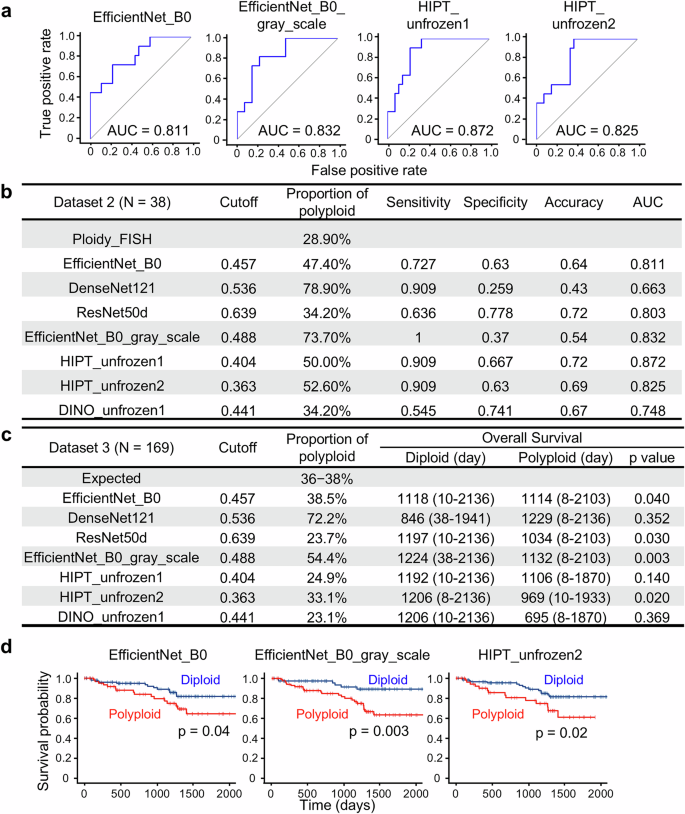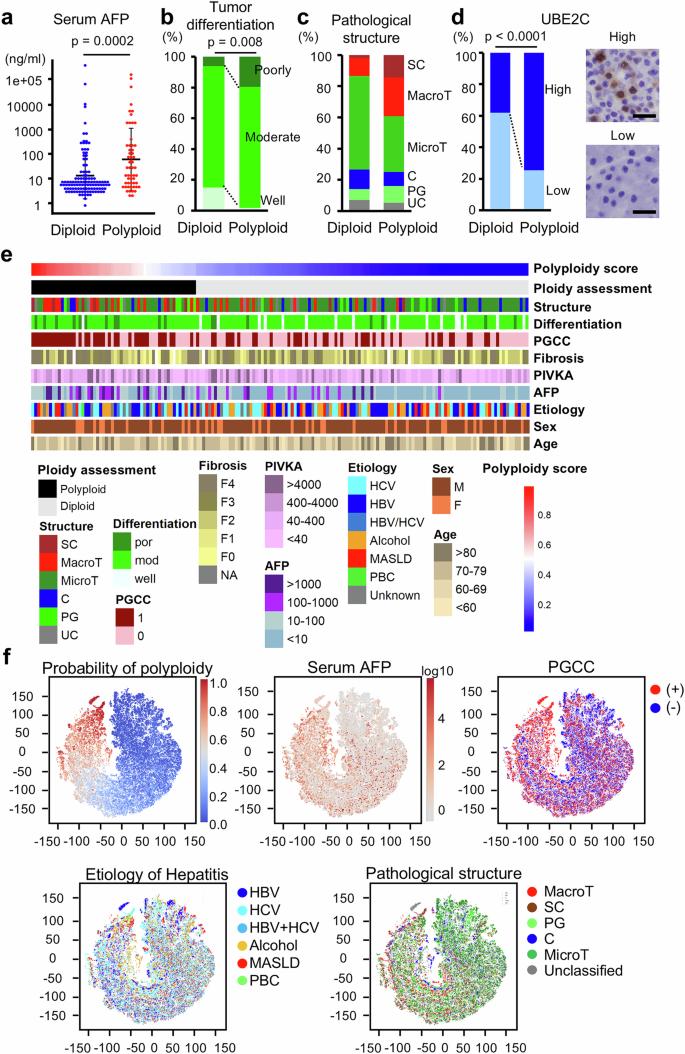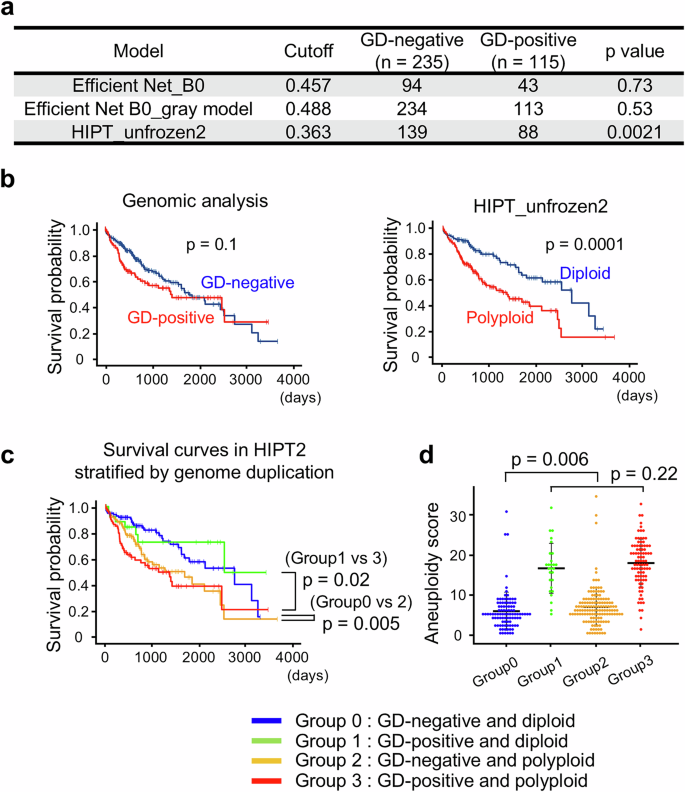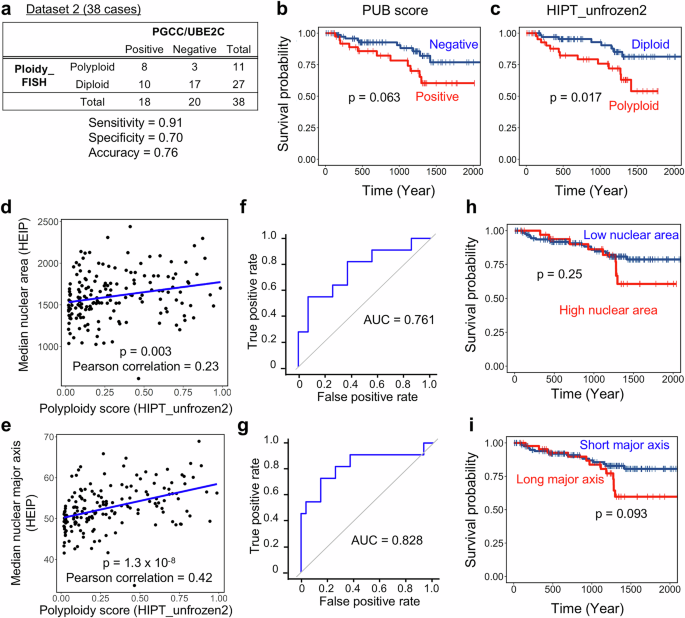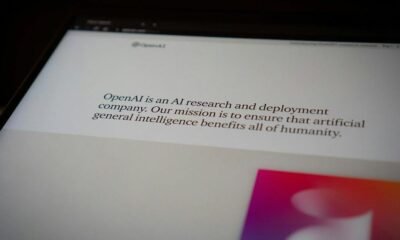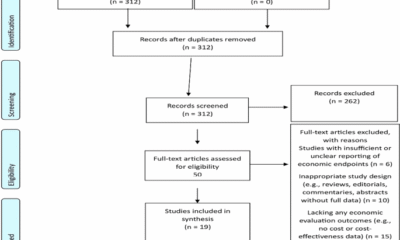AI Research
Selective identification of polyploid hepatocellular carcinomas with poor prognosis by artificial intelligence-based pathological image recognition
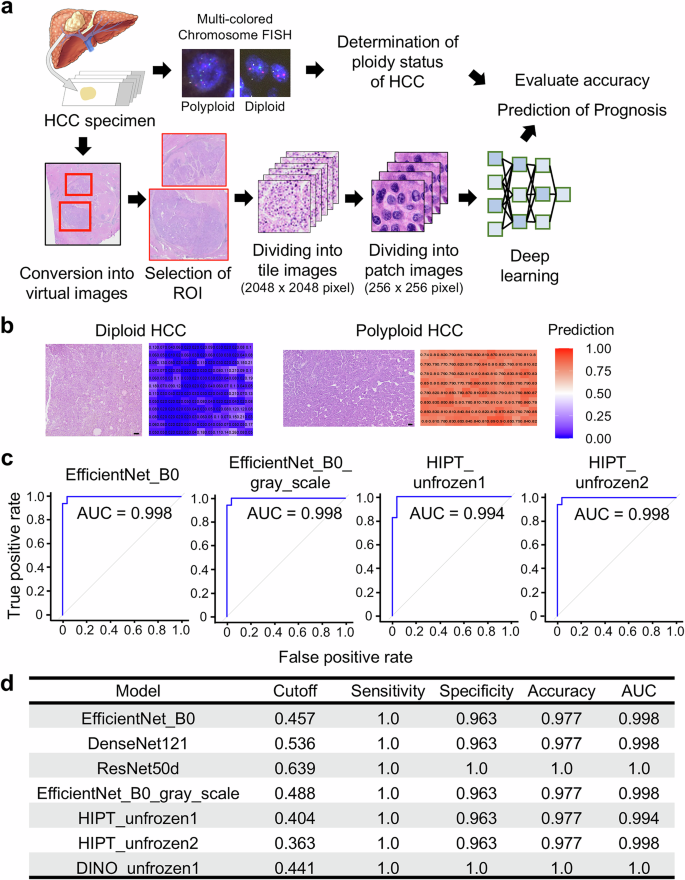
Development of an AI-based image recognition model to estimate HCC ploidy
First, we constructed a model to evaluate the ploidy status of HCC using deep learning and CNN-based image classification. A total of 44 cases whose ploidy status had been determined by chromosome FISH in our previous study6 were used as the training data. The training set included 27 diploid and 17 polyploid HCC cases. After obtaining a whole-slide image of the HE-stained slide for each tumor, we selected three or more ROIs showing the representative pathological appearance of the tumor (Fig. 1a). Each ROI was divided into 2048×2048-pixel tiles, and the tiles were subdivided into 256 × 256 patches for input into the deep-learning algorithm (see Materials and Methods). Deep learning for tumor ploidy classification was performed by training 42,240 small-patch images. The models calculated the probability of tumor polyploidization in each 2048 × 2048-pixel tile, and the average value across all tiles for each tumor was defined as the polyploidy score for the tumor (Fig. 1b, Supplementary Fig. 4).
a Scheme for the construction of AI-based image recognition models for determining HCC ploidy. b Representative HE-stained images of ROIs in diploid and polyploid HCC. The probabilities of HCC polyploidization in the corresponding 2048 × 2048-pixel tiles are shown in a color map. Scale bar, 200 μm. c ROC curves and AUC values of representative AI models in cross-validation. The data for the other models are shown in Supplementary Fig. 5. d Evaluation and comparison of the constructed AI models.
We first used three CNN-based image classification models: DenseNet12115, ResNet50d16, and EfficientNet_B017. The validity of the models was assessed by analyzing their receiver operating characteristic (ROC) curves and areas under the curve (AUC)24 (Fig. 1c, Supplementary Fig. 5). Five-fold cross-validation revealed that all three models achieved high AUC values (0.998−1.0, Fig. 1d). For example, with the optimized cutoff value (0.457) of polyploidy score determined based on the ROC curve, the EfficientNet_B0-based model exhibited high accuracy, sensitivity, and specificity (0.977, 1.0, and 0.963, respectively, Fig. 1d, Supplementary Fig. 6). These findings indicate that CNN-based models can be used to evaluate the HCC ploidy status using pathological HE images.
AI-based image recognition successfully assessed HCC ploidy at a low calculation cost
The coloration of HE staining is known to vary due to factors such as fixation conditions and staining protocols, potentially affecting AI model performance25,26. To address this, we constructed a model using EfficientNetB0 on grayscale-converted images to minimize the impact of such variability. The constructed EficientNetB0_gray model showed a high AUC value (0.998), comparable to that of the original CNN-based models, suggesting that the cellular morphological information obtained from grayscale images was sufficient to evaluate HCC ploidy (Fig. 1c, d, Supplementary Fig. 6).
We also developed models using ViT-based architectures, which incur lower calculation costs than CNN-based image recognition. Two and one models were constructed using HIPT20 and DINO19, respectively, both of which enabled the scalability of ViT to large images via self-supervised learning (see Materials and Methods). These encoders were trained on TCGA or liver pathology images obtained at our institution. By freezing parts of the model during training, overfitting can be moderated, even when the labeled data are insufficient. In particular, because it allows for easy replacement of the first stage with other publicly available models trained on pathology images using self-supervised learning, model construction using HIPT requires a shorter learning time than CNN-based models. All three models exhibited high accuracy and AUC values that were comparable to those of the CNN models (Fig. 1d, Supplementary Fig. 6).
AI-based ploidy assessment identified polyploid HCC cases with poor prognosis within a large cohort
We examined whether our constructed AI models could properly assess HCC ploidy using a separate dataset. Tumor ploidy was determined using chromosome FISH in 38 new HCCs (Dataset 2) that were not included in the first dataset (Dataset 1). Their polyploidy scores were then calculated by analyzing their HE images using AI models. The sensitivity, specificity, and proportion of polyploid HCC were determined based on the cutoff values determined in the analysis of Dataset 1 (Fig. 1d, Supplementary Fig. 6). Among the models examined, some, including the two HIPT-based models, exhibited relatively high AUC values over 0.8 (Fig. 2a, b). The decrease in accuracy observed in Dataset 2 compared to Dataset 1 may be attributed to the fact that cases with typical histology of diploid and polyploid cancers were used for training in Dataset 1, while cases in Dataset 2 were selected in an unbiased manner.
a, b Performance of AI models in the validation assessments. The ploidy statuses of 38 HCCs (determined by chromosome FISH) were compared with the ploidy statuses, as assessed by AI models. ROC curves of the representative AI models are shown in (a). c Prognostic stratification based on ploidy assessments by the AI models. A total of 169 HCCs were analyzed. d Kaplan–Meier curves of overall survival. Statistical difference was determined by log-rank test. The three AI models that identified a significant difference in prognosis between diploid and polyploid HCCs in (c) are shown.
To further evaluate the utility of AI-based polyploid HCC identification, a large cohort of 169 HCC cases (Dataset 3) was examined using AI models (Fig. 2c). In particular, the EfficientNet_B0-based and HIPT_unfrozen2 models diagnosed a number of polyploid HCC cases proportional to their prevalence, as shown in previous reports (36–38% 3,6). By identifying polyploidy in HCC, the EfficientNet_B0-based and HIPT_unfrozen2 models discriminated HCC patients with significantly worse overall survival after surgery (Fig. 2c, d, Supplementary Fig. 7). These findings indicate that AI models, especially the HIPT_unfrozen2 model, are useful for identifying polyploid HCC and predicting poor prognosis.
Analysis of a large cohort revealed the characteristics of polyploid HCC
The HIPT_unfrozen2 model, which exhibited the most optimal features for ploidy determination among the constructed models, was used to investigate the characteristics of polyploid HCC by analyzing a large cohort. In Dataset 3, consisting of 169 cases, 113 and 56 cases were diagnosed as diploid and polyploid HCC, respectively, using the HIPT_unfrozen2 model. As observed in other datasets, where no associations were found between tumor ploidy and age, sex, or body mass index (Supplementary Table 1), the two groups showed no significant differences in these variables (Table 1, Supplementary Fig. 8). Consistent with our previous results, serum alpha-fetoprotein (AFP) levels were significantly higher in polyploid HCC than in diploid HCC, whereas tumor size and stage were comparable between the two groups (Table 1, Fig. 3a). Polyploid HCC was also significantly associated with a high prevalence of poor differentiation and exhibited MTM or scirrhous structures (Table 1, Fig. 3b, c). Polyploid giant cancer cells (PGCCs), which exhibit a distinct appearance with prominently large nuclei or profound multinucleation, are frequently observed in polyploid HCC (Table 1). Furthermore, the expression of UBE2C, which we previously reported as a marker suggestive of polyploid HCC, was significantly elevated in polyploid HCC relative to levels in diploid HCC (Fig. 3d). These findings confirm the characteristics of polyploid HCC demonstrated in our previous study and suggest accurate ploidy evaluation by our HIPT_unfrozen2 model. In addition, most polyploid HCCs diagnosed using the AI model did not exhibit well-defined pathological features characteristic of polyploid HCC (Fig. 3e), indicating that the AI model comprehensively assessed ploidy in HCC, considering a complex array of histological information beyond mere tumor structures and differentiation status.
a Serum AFP levels. Error bars indicate mean ± SD. b, c Pathological classification of HCC differentiation and structure. d Immunostaining of UBE2C. Scale Bar 50μm. e Heatmap indicating ploidy scores assessed using the HIPT_unfrozen2 model and clinicopathological features. f t-SNE plots of tile images. Probabilities of polyploidy assessed using the HIPT_unfrozen2 model and clinicopathological features of the tumors are shown. A total of 169 HCCs were analyzed. SC scirrhous, MacroT macro-trabecular, MicroT micro-trabecular, C compact, PG pseudo-glandular, UC unclassified, PIVKA protein induced by vitamin K absence or antagonist II, HBV hepatitis b virus, HCV hepatitis c virus, MASLD metabolic dysfunction associated steatotic liver disease, PBC primary biliary cholangitis.
To further explore the characteristics of polyploid HCC, we visualized case-by-case correlations between the polyploidy scores and clinicopathological features (Fig. 3e). In addition, data derived from all 2048 × 2048-pixel tile images of the 169 HCCs were compressed into two dimensions and visualized using t-SNE plots (Fig. 3f). These plots validated that high serum AFP levels were correlated with high polyploidy probability values calculated using our AI models. Interestingly, HCCs with high polyploidy scores were predominantly positive for PGCCs, highlighting their importance in inferring HCC polyploidy (Fig. 3e). In contrast, hepatitis etiology seemed to exert little influence on HCC ploidy, and HCCs with high polyploidy scores developed in livers with viral hepatitis and steatotic liver diseases (Fig. 3e, f). Our investigation of poorly understood features of polyploid HCC in a large cohort, utilizing the high-throughput analysis capabilities of AI models, verified recently revealed characteristics and provided additional insights.
The AI model robustly identified polyploid HCC in a public dataset and predicted a poor prognosis
To further verify the utility of the AI-based ploidy discrimination models, we analyzed the HE images of 350 HCC cases in the public TCGA dataset using our representative models, EfficientNet_B0, EfficientNet_B0_gray, and HIPT_unfrozen2. Ploidy assessments obtained by these AI models were compared with a prior determination of genome duplication (GD) by SNP array analysis of tumor genomes4,5. Assessment using the HIPT_unfrozen2 model showed a strong correlation with the GD status determined by genomic analysis (Fig. 4a). The other two models did not demonstrate a significant correlation. Using the GD status based on genomic analysis as a reference, the sensitivity and specificity of the HIPT_unfrozen2 model were 0.77 and 0.41, respectively. Similar to Dataset 3, the polyploid HCC in the TCGA dataset identified by the HIPT_unfrozen2 model showed a high prevalence of PGCC and elevated AFP serum levels, supporting the idea that the AI model can robustly evaluate HCC ploidy status from pathological images obtained under heterogeneous conditions at various facilities (Table 2).
a Conformity between GD detected by genomic analysis and the ploidy status assessed using our AI models. b, c Kaplan–Meier curves displaying overall survival. Statistical difference was determined by log-rank test. d Aneuploidy score. A total of 350 HCC cases in TCGA dataset were divided by their GD status detected by genomic analysis and their ploidy status assessed using the HIPT_unfrozen2 model. Error bars indicate mean ± SD.
We further examined whether the HIPT_unfrozen2 model was helpful in identifying a subset of HCC with poor prognosis. As expected, GD-positive HCC evaluated by genomic analysis showed a trend toward poor prognosis compared to GD-negative HCC, although the difference was weak and insignificant (Fig. 4b). In notable contrast, polyploid HCC identified by the HIPT_unfrozen2 model exhibited markedly poorer prognosis than their diploid counterpart (Fig. 4b). Among the 350 HCCs, the images of 188 cases were designated suboptimal for diagnosis because a substantial proportion of their ROIs were affected by necrosis, severe fibrosis, and contamination with nontumor components. Importantly, however, the HIPT_unfrozen2 model similarly distinguished prognostic differences depending on ploidy status, regardless of the inclusion of these 188 suboptimal cases, highlighting the robust diagnostic capacity of the AI model (Supplementary Fig. 9).
To explore the reasons for the differences in ploidy-related prognostic prediction capability between the HIPT_unfrozen2 model and genomic analysis, TCGA cases were categorized into four groups based on the AI (diploid or polyploid) and genomic results (GD-positive or GD-negative). As expected, GD-positive polyploid HCC had a significantly poorer prognosis than GD-negative diploid HCC (Fig. 4c). Interestingly, polyploid but GD-negative HCC exhibited a poor prognosis, comparable to that of GD-positive polyploid HCC. In addition, diploid but GD-positive HCC showed a good prognosis, similar to that of GD-negative diploid HCC. The HIPT_unfrozen2 model consistently identified HCC with a significantly poorer prognosis regardless of the SNP array results, leading to its superior prognostic prediction over genomic analysis (Fig. 4c). Moreover, among the GD-negative HCC identified using the SNP array, AI-diagnosed polyploid HCC had significantly more chromosomal aberrations than their diploid counterparts (Fig. 4d), suggesting that the AI model distinguished HCC with a poor prognosis by detecting chromosomal instability and polyploidy from pathological images. These findings indicate that our AI model interpreting HCC ploidy status from pathological images can robustly identify HCC with poor prognosis across diverse conditions in multiple facilities.
The HIPT_unfrozen2 model outperforms conventional methods for estimating HCC ploidy from pathological images
Finally, we compared HIPT_unfrozen2 with existing methods for estimating HCC ploidy from pathological images, evaluating their performance in ploidy classification and prognosis prediction. In our previous study, we proposed a scoring system (PUB score) that combines PGCC detection in HE-stained sections with immunostaining for UBE2C to infer polyploidization in HCC6. When tumors exhibiting both PGCC presence and UBE2C overexpression were classified as polyploid, the PUB classification achieved an accuracy of 0.76 (sensitivity: 0.91, specificity: 0.70) in Dataset 2 (Fig. 5a), which is comparable to that of the AI models. Among the 118 cases in Dataset 3 with available UBE2C immunostaining, the PUB classification identified a group with a poor prognosis, although the difference was not statistically significant (p = 0.063, Fig. 5b). In contrast, HIPT_unfrozen2 distinguished the poor prognosis group more clearly and significantly in the same cases, suggesting that while the combination of PGCC and UBE2C is a useful marker, AI-based ploidy assessment is more effective for predicting prognosis through tumor ploidy classification (p = 0.017, Fig.5c).
a Performance of PUB classification for assessing HCC ploidy. Tumors exhibiting both PGCC presence and UBE2C overexpression were classified as PUB-positive. b, c Kaplan–Meier curves for overall survival. A subset of Dataset 3 (n = 118) with available UBE2C immunostaining was analyzed according to PUB classification and HIPT_unfrozen2 assessment. Correlation between nuclear morphology features extracted by HEIP and the polyploidy score calculated by HIPT_unfrozen2. Median nuclear area (d) and median nuclear major axis (e) were derived from 169 cases in Dataset 3. ROC curves and AUC values for assessing HCC ploidy using median nuclear area (f) or median nuclear major axis (g) extracted by HEIP. Dataset 2 was used for analysis. Kaplan–Meier curves for overall survival analyzed based on the median nuclear area (h) or median nuclear major axis (i). Cases in Dataset 3 were stratified using cutoff values determined by ROC curves in f, g based on the Youden method. In b, c, f, g, statistical significance was assessed using the log-rank test.
We also compared HIPT_unfrozen2 with another published AI-based tool that assesses tumor ploidy by evaluating nuclear morphology, the HE Image Processing pipeline (HEIP)27, using the same HE-stained images analyzed in our study. After segmenting cell nuclei, we identified tumor nuclei using the HEIP algorithm and assessed tumor ploidy based on two morphological features: nuclear area, which is known to correlate with ploidy28, and the nuclear major axis, which was reported as the most strongly correlated feature in the original study27. As expected, both the median tumor nuclear area and the median nuclear major axis extracted by HEIP showed a highly significant correlation with the polyploidy score calculated by HIPT_unfrozen2, suggesting that HEIP accurately captured tumor nuclear morphology (Fig. 5d, e). Using Dataset 2, where tumor ploidy was confirmed by chromosome FISH, we assessed the performance of HEIP in tumor ploidy classification through ROC analysis, yielding AUC values comparable to that of HIPT_unfrozen2 (0.761 for nuclear area and 0.828 for the nuclear major axis, Fig. 5f, g). We further examined the prognostic utility of HEIP-based tumor ploidy assessment in Dataset 3. When tumors were stratified by the nuclear area, no significant difference in prognosis was observed between the high (n = 35) and low (n = 134) groups (log-rank, p = 0.25, Fig. 5h). Stratification using the nuclear major axis showed better separation of prognostic groups, but the difference remained statistically insignificant (log-rank, p = 0.093, Fig. 5i).
Taken together, these findings indicate that HIPT_unfrozen2 outperforms conventional methods in classifying tumor ploidy and stratifying prognosis based on pathological images of HCC.
AI Research
GAO Review Finds 94 Federal AI Adoption Requirements
AI Research
South Korea Looks to Canadian Energy to Fuel its AI Ambitions

Artificial intelligence (AI) and clean energy technologies have emerged as central policy pillars of the new Lee Jae Myung government in South Korea, as part of his administration’s strategy to revitalize the economy.
Recognizing that the country has lagged behind global leaders such as the U.S. and China, both of which have adopted robust industrial policies, Lee’s government plans to introduce a South Korean version of the Inflation Reduction Act, a massive government investment plan to promote key strategic sectors. Similar to the U.S. act, Lee’s initiative aims to provide large-scale subsidies and targeted government financing to accelerate growth in strategic sectors, with AI and clean energy at the forefront.
Within this broader policy shift, the nexus between AI and energy has gained prominence. The rapid scaling up of energy-intensive AI infrastructure has sent energy demand soaring. As a result, South Korea needs to ensure a sustainable and resilient power supply for the digital economy. South Korea is one of the countries leading efforts to integrate energy policy and AI strategy in a way that both promotes innovation and strengthens energy security.
The evolution of South Korea’s AI governance
South Korea laid a foundation for AI governance in its 2024 Framework Act on Artificial Intelligence, one of the world’s first comprehensive national AI laws. Enacted under Lee’s predecessor, Yoon Suk Yeol, the act was designed to foster innovation while ensuring transparency, safety, and public accountability.
Shortly after assuming the presidency in early June, Lee elevated AI to a central role in South Korea’s national growth agenda. His administration’s blueprint aims to position the country among the world’s top three AI powers. Adopting a ‘develop-first, regulate-later’ philosophy, the plan emphasizes ecosystem expansion, including C$97 billion (100 trillion South Korean won) in AI investments, the designation of data centres as critical infrastructure, and the rollout of an “AI Highway” to connect regional tech clusters. Simultaneously, the administration is continuing to build on the AI Framework Act, working to implement its provisions early in Lee’s five-year term to ensure legal stability and time to build public trust, particularly around issues such as data privacy and algorithmic bias.
A notable feature of this approach is integrating the country’s tech-sector leaders into policy roles. For example, the head of Naver’s AI Center was appointed presidential secretary for AI policy, and the president of LG AI Research now serves as minister of science and Information and Communications Technology. In addition, a centralized AI governance body within the presidential office now co-ordinates interministerial initiatives and accelerates regulatory reforms in close dialogue with the private sector.
To ensure that the strategy is well resourced, the government has earmarked C$970 million (1 trillion won) in public investment for AI research and development (R&D), in addition to a C$330-billion (340 trillion won) investment in three ‘game-changing’ technologies: AI semiconductors, advanced biotechnology, and quantum technology. Additionally, a national AI computing centre, costing C$2 billion (2 trillion won), is expected to open by 2027. These developments reflect a national effort to accelerate AI innovation to give South Korea the upper hand in technologies that are indispensable within the global value chain.
Key challenges in the AI–energy nexus
As South Korea pushes forward with its AI agenda, one of its most pressing challenges is building a sufficient and reliable energy supply. The explosive growth of AI infrastructure is substantially increasing demand on South Korea’s energy grid, with wide-ranging implications for both industrial competitiveness and climate goals.
The expansion of AI computing, especially through hyperscale data centres, is driving this steep growth in demand. A landmark 3 gigawatt data centre project in Jeollanam-do Province is expected to go online by 2028 to accommodate the compute intensity of next-generation AI applications. National electricity demand is projected to double by 2030 relative to 2022 levels, driven largely by data centres and semiconductor fabrication plants — two sectors at the heart of South Korea’s digital strategy.
Already, the country’s aging power grid is struggling to keep pace with this growth. Approximately 78 per cent of existing data centre power use is concentrated in the Seoul metropolitan area, straining the city’s local infrastructure. Although the government has pushed to relocate the data centre to other provinces through the Special Act on Distributed Energy (which came into effect in June 2024), to date, no such news of this relocation has been reported. Experts warn that without rapid modernization, grid bottlenecks could compromise supply stability and industrial growth. In response, the government enacted the Power Grid Act in February 2025 to expedite grid expansion, including provisions for enhanced compensation to communities affected by new transmission lines. The act also encourages public-private investment and regulatory reforms to streamline power purchase agreements and other procedures related to utilities.
To support its expanding AI infrastructure and meet AI-driven energy demands, South Korea is turning to liquefied natural gas (LNG) and nuclear power as its main sources of reliable electricity. Plans are underway to convert 28 aging coal-fired plants to run on LNG and to build two new nuclear reactors by 2038, supplementing the four already under construction. In contrast to former president Moon Jae-in’s (2017-22) nuclear phase-out policy, recent developments — including a speech by Lee during the recent election campaign and the appointment of Kim Jeong-gwan, president of Doosan Enerbility (a major national conglomerate deeply engaged in nuclear energy development), as minister of trade, industry and energy — suggest that the current administration recognizes the challenges of relying solely on renewables and the necessity of re-introducing nuclear energy. These signals indicate a pragmatic approach to building a renewables-centred energy system while maintaining energy security.
In the same vein, Seoul also sees small modular reactors (SMRs) as a promising long-term solution for powering AI infrastructure and carbon neutrality. The first 0.7-gigawatt SMR is expected to be deployed by 2036. Meanwhile, Korea Hydro & Nuclear Power (KHNP), one of the Korea Electric Power Corporation’s subsidiaries operating nuclear and hydroelectric plants, is advancing its innovative SMR design, aiming to finalize the standard design by the end of 2025. SMRs are increasingly favoured as a go-to solution to meet soaring AI-driven energy demand, not just in South Korea but elsewhere. For example, large tech companies such as Amazon and Google have pledged to increase their nuclear-power capacity by 2050, paying particular attention to SMRs for their potential to provide localized, carbon-free power generation for data centre clusters and industrial complexes.
Canada–South Korea co-operation: a strategic convergence
No country can achieve the dual goals of securing sustainable energy and fuelling the AI boom on its own. As South Korea bolsters its AI-energy strategy, cross-border collaboration will become indispensable. Canada has emerged as a key partner in this space.
Stable access to critical minerals and nuclear fuel is essential to South Korea’s energy security and growing AI infrastructure. In 2024, 48 per cent of the country’s enriched uranium imports (by value) came from Russia. However, amid heightened geopolitical risk, South Korea is shifting to more secure suppliers. Canada, the world’s second-largest supplier, with an 18 per cent global share in 2024, is expected to play an increasingly vital role. This diversification strategy not only reduces South Korea’s dependence on Russia but also boosts the long-term sustainability of its nuclear power fleet.
Nuclear technology and fuel have long been central to Canada–South Korea technology co-operation. Canada’s CANDU heavy-water reactors form a key part of South Korea’s nuclear infrastructure, with four CANDU reactors currently in operation at Wolsong. The bilateral nuclear co-operation has been well exemplified in the recent memoranda. In 2023, the Korea Atomic Energy Research Institute (KAERI) signed a memorandum of understanding (MOU) with Alberta’s provincial government to explore deploying the South Korea-designed SMART SMRs in Alberta, targeting applications such as oil sand steam generation. In the same year, KAERI and Canada’s Atomic Energy of Canada Limited signed a nuclear R&D MOU focusing on placing South Korean SMR designs into global markets, with an emphasis on collaboration with Canada. In May 2024, KHNP, Canada’s SMR developer, ARC Clean Technology, and New Brunswick Power signed a trilateral agreement to co-develop and deploy the ARC-100 advanced SMR, including mass deployment plans, starting with a demonstration at Point Lepreau, New Brunswick.
Bilateral AI collaboration is also in the works. In June 2024, the National Research Council of Canada and South Korea’s National Research Council of Science and Technology renewed their MOU, reaffirming joint R&D co-operation in AI and digital technologies. The agreement supports exchanges of researchers, joint innovation projects, and the development of collaborative infrastructure.
Finally, ethical AI governance — specifically South Korea’s AI Framework Act — can serve as a valuable reference point for Canada as it develops its own regulatory framework. Both countries emphasize transparency, safety, and accountability in AI, and their joint participation in forums such as the OECD and the Global Partnership on AI offers meaningful avenues for co-ordination. Collaborative efforts in this space would not only promote responsible innovation but also contribute to shaping global norms grounded in democratic values.
As South Korea accelerates its AI ambitions, the question of energy resilience has become inseparable from digital innovation. The AI-energy nexus is now a strategic domain where governance, infrastructure, and international partnerships converge. Canada, with its deep expertise in nuclear technology and growing AI ecosystem, is uniquely positioned to collaborate with South Korea in building a secure, ethical, and sustainable digital future.
• Edited by Jeehye Kim, Senior Program Manager, Northeast Asia, Vina Nadjibulla, Vice-President Research & Strategy, and Ted Fraser, Senior Editor, APF Canada
AI Research
Cybercrook dupes Pune-based private varsity of Rs2.5cr with ‘govt research funding in drones & AI tech’ bait | Pune News

Pune: The Pune Cyber Police are investigating a city-based private university’s complaint about being cheated of Rs 2.46 crore between July 25 and Aug 7 by a cybercriminal in the name of “govt-aided research funding opportunities in drones and AI technology” fields.The crook misused the name of a former vice-chancellor of Savitribai Phule Pune University (SPPU) to send a message on the smartphone to the private university’s chief education officer (CEO), stating that a person would call him to give details of a research funding opportunity. The message also contained the person’s name and number.The CEO called this number, and the man at the other end identified himself as an ‘IIT Mumbai professor’ and told him about a Department of Science and Technology (DST) and DRDO’s Rs28 crore drone project. The man told the CEO that the private university must transfer 2% of the amount, i.e., Rs 56 lakh, within three hours to get eligibility and funding for the project.The CEO then discussed the matter with the higher-ups and finance officers, and Rs56 lakh was first transferred on July 25. The crook called again on July 30 and Aug 7 and got the university to transfer Rs 46 lakh and Rs 1.44 crore for two other projects. He told the CEO that he would visit Pune on Aug 28 to sign an MoU with the private university. However, as the man did not turn up, the CEO then called the professor at IIT Mumbai, who said he was never part of any such research funding plan. The same day, the CEO lodged a complaint application. After verification of the complaint, the Cyber Police lodged an FIR on Sept 6.On Wednesday, the private university issued a statement to TOI which read: “Clear standard operating procedures and due diligence processes are maintained for all collaborations. This was a unique case of impersonation in which the documents and communication were made to look authentic. Once the fraud was detected by internal mechanisms, the transfers were stopped, and a cybercrime complaint was filed immediately.“An official from the private university, who did not wish to be named, told TOI: “The man, who was talking to us regarding the research funding opportunity, sounded quite convincing with technical know-how. It never occurred to us that he was an impersonator.”A cyber police officer said: “After the first money transfer of Rs56 lakh, the impersonator contacted the CEO with a funding opportunity in an Artificial Intelligence (AI) technology project, claiming that govt has sanctioned Rs 23 crore for it and the private university needed to transfer Rs 46 lakh. The money was transferred. On Aug 7, the caller sold the idea of a new project in machine learning, claiming that govt has sanctioned Rs72 crore and to get the amount the private university must transfer Rs1.44 crore.“He said: “After the caller’s assurance of visiting the private university for signing an MoU on Aug 28, the CEO tried calling him on Aug 26. But his number was not reachable. The CEO then gathered the professor’s contact number from IIT Mumbai and was shocked to know that someone else had used the latter’s name and number to dupe the university.”Investigations so far revealed that the money was transferred to a public sector bank’s account in Hyderabad. “We have sought the details of that bank account,” he said.
-

 Business2 weeks ago
Business2 weeks agoThe Guardian view on Trump and the Fed: independence is no substitute for accountability | Editorial
-
Tools & Platforms4 weeks ago
Building Trust in Military AI Starts with Opening the Black Box – War on the Rocks
-

 Ethics & Policy2 months ago
Ethics & Policy2 months agoSDAIA Supports Saudi Arabia’s Leadership in Shaping Global AI Ethics, Policy, and Research – وكالة الأنباء السعودية
-

 Events & Conferences4 months ago
Events & Conferences4 months agoJourney to 1000 models: Scaling Instagram’s recommendation system
-

 Jobs & Careers2 months ago
Jobs & Careers2 months agoMumbai-based Perplexity Alternative Has 60k+ Users Without Funding
-

 Education2 months ago
Education2 months agoVEX Robotics launches AI-powered classroom robotics system
-

 Podcasts & Talks2 months ago
Podcasts & Talks2 months agoHappy 4th of July! 🎆 Made with Veo 3 in Gemini
-

 Education2 months ago
Education2 months agoMacron says UK and France have duty to tackle illegal migration ‘with humanity, solidarity and firmness’ – UK politics live | Politics
-

 Funding & Business2 months ago
Funding & Business2 months agoKayak and Expedia race to build AI travel agents that turn social posts into itineraries
-

 Podcasts & Talks2 months ago
Podcasts & Talks2 months agoOpenAI 🤝 @teamganassi

